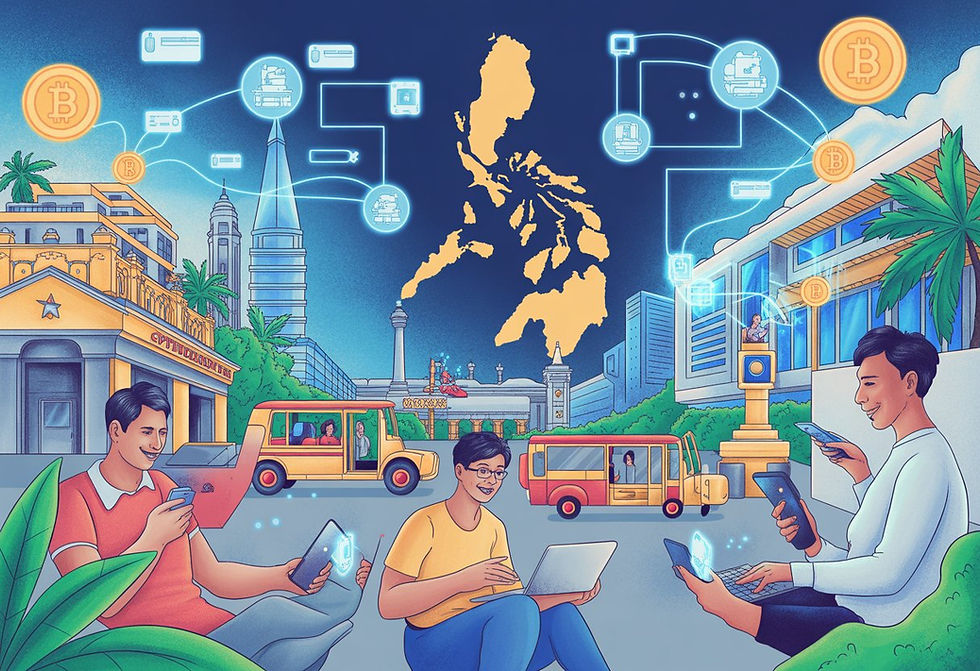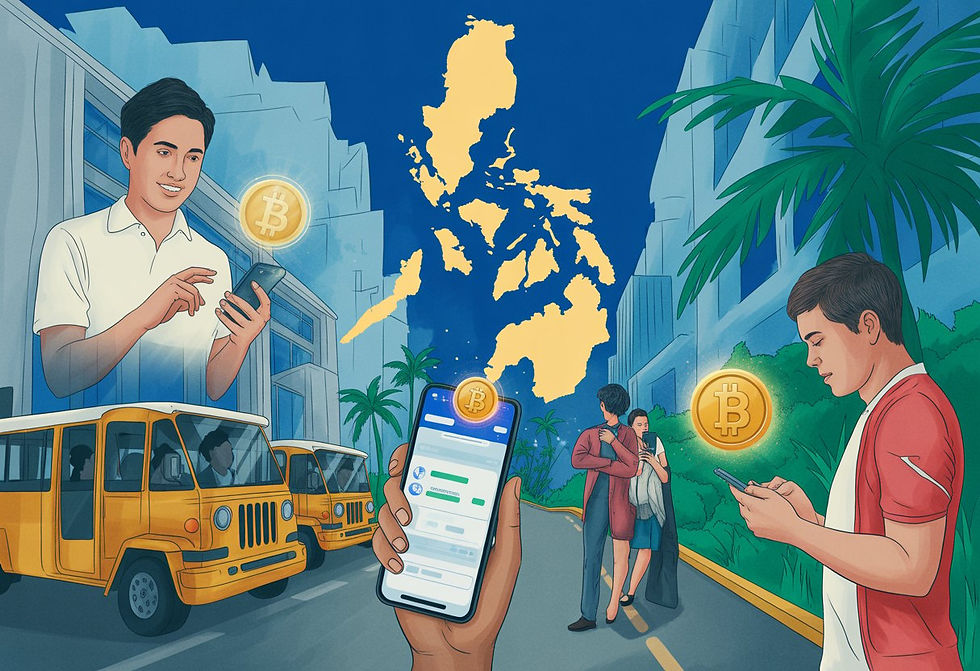Crypto Adoption in Southeast Asia: The Philippines Remittance Market
- The Master Sensei

- Sep 2
- 4 min read
Updated: Oct 27
Southeast Asia has become a global hotspot for cryptocurrency. Millions now use digital assets for daily finances. With a young, tech-savvy crowd and not-so-great access to banks, crypto just makes sense here.

The Philippines stands out as a leader in this trend, ranking among the top countries worldwide for cryptocurrency use, particularly in the remittance market where people send money across borders. Filipino workers abroad now send money home with crypto because it’s faster and cheaper than the old-school ways. This shift has changed how families get support from overseas.
But it’s not just about sending money. Play-to-earn games, mobile payments, and new investment opportunities have all pushed crypto into the mainstream. Looking at this market, you can see how developing economies can really benefit from blockchain—though, of course, there are always regulatory headaches and risks to watch out for.
Crypto Adoption in Southeast Asia and the Philippines Remittance Market
Southeast Asia leads global cryptocurrency adoption, making up 60% of worldwide activity. About 30% of the region’s remittances now use crypto. Countries like the Philippines, Vietnam, and Indonesia push this growth—strong digital payment networks and lots of overseas workers help fuel it.

Drivers of Crypto Adoption for Remittances
The Philippines faces unique challenges that make cryptocurrency attractive for remittances. Roughly 76% of Filipinos don’t have access to regular banking.
Nearly everyone has a smartphone, and internet access is growing fast. People send and receive money on their phones—no bank account needed.
Cost savings matter a lot. Traditional money transfers charge high fees and can take days to process.
Crypto remittances move money across borders much faster. Transfers that used to drag on for 3-5 business days now finish in just a few hours.
When the COVID-19 pandemic hit, crypto adoption in the Philippines accelerated. Many Filipinos turned to blockchain games like Axie Infinity to earn money during lockdowns.
Gaming culture introduced millions to crypto. Players picked up how to use digital wallets and trade tokens for real cash.
Regional Leaders: India, Vietnam, Indonesia, and the Philippines
Verifiable data puts Thailand, the Philippines, and Vietnam at the top for global crypto adoption. These countries drive Southeast Asia’s $10 billion crypto shift.
The Philippines ranks 5th globally for crypto ownership. About 16 million Filipinos own crypto—13.4% of the population.
Vietnam’s no slouch either. Around 21% of people there use digital assets, thanks to a tech-savvy crowd and limited banking options.
Indonesia’s also a major player. Its huge population and growing digital economy push adoption higher every year.
India has a big impact in Asia-Pacific crypto remittances, mostly because of its massive overseas worker population.
Together, these four countries make up most of the region’s crypto remittance activity. Their users keep driving new ideas in crypto payments.
Key Players and Platforms in the Remittance Ecosystem
The Bangko Sentral ng Pilipinas (BSP), the Philippines' primary monetary regulation agency, has approved over a dozen crypto exchanges. Major names include Philippine Digital Asset Exchange (PDAX), Coins.ph, and Juancash.
Coins.ph rolled out PHPC, a stablecoin tied to the peso. It’s designed to make sending money home cheaper for overseas Filipino workers.
Digital wallets like GCash and Maya now handle more remittances than ever. Visa says 75% of remittances to the Philippines use digital platforms these days.
Old-school providers like Western Union and MoneyGram now compete with crypto options. Local outfits like Cebuana Lhuillier and Palawan Express feel the pressure too.
The central bank’s Project Agila is testing a wholesale Central Bank Digital Currency, aiming for a launch by 2029.
Filipinos still love Bitcoin. About 37% of crypto owners in the Philippines hold Bitcoin for remittances and savings.
Opportunities, Challenges, and the Regulatory Landscape
The Philippines crypto remittance market faces tricky regulations, even as digital currencies open new doors for financial inclusion. Central banks are rolling out new rules for virtual assets while stablecoins and CBDCs look like the next big thing for cross-border payments.
Financial Inclusion and Impact on the Unbanked
Crypto gives millions of unbanked Filipinos access to financial services they never had. Traditional banks only reach about half the population, especially missing folks in rural areas.
Digital currencies let workers get remittances right on their phones, no need for a physical bank. Crypto exchanges make it easy and fast to receive money.
Key benefits for unbanked populations:
Lower transaction fees than traditional money transfer services
Access to financial services any time, day or night
No minimum balance needed
Peer-to-peer transfers with no middleman
Crypto trading platforms have become gateways to more financial services.
Many exchanges now offer savings and lending options too. These weren’t available to people without bank accounts before.
It’s not just individuals who benefit. Small businesses can accept digital payments and reach global markets, creating new opportunities in places that used to be left out.
Stablecoins, CBDCs, and Their Role in Remittances
Stablecoins have taken over as the go-to for crypto remittances in the Philippines. USDT and USDC now make up over 70% of the market here.
Because these digital currencies stay pegged to the US dollar, users don’t have to worry about wild price swings like with Bitcoin or Ethereum. Recipients can convert stablecoins to pesos without nasty surprises.
The Bangko Sentral ng Pilipinas (BSP) is looking into a central bank digital currency (CBDC)—a government-backed digital peso for remittances and payments at home.
Regulatory Developments: BSP, Central Banks, and Market Oversight
The Bangko Sentral ng Pilipinas (BSP) has rolled out detailed rules for virtual assets. These cover everything from cryptocurrency exchanges to wallet providers and remittance operators.
Licensed crypto exchanges have to meet strict compliance standards. They need enough capital tucked away and solid measures to protect customers. If a crypto transaction goes above a certain amount, anti-money laundering rules kick in.
The BSP tells remittance companies to register if they deal with virtual assets. That way, crypto remittances fall under the same watchful eye as regular money transfers.
Current regulatory framework includes:
Licensing requirements for crypto exchanges
Customer due diligence procedures
Transaction monitoring systems
Capital adequacy standards
Central banks in Southeast Asia talk to each other about crypto policies. They’re trying to line up their approaches for cross-border crypto transactions, though it’s not always simple.
Market oversight leans heavily on consumer protection and keeping the financial system steady. The BSP keeps an eye on crypto trading volumes and market risks. They run regular stress tests to make sure exchanges can handle big waves of withdrawals.
They're also working on new rules for stablecoin issuers. These will probably require proper reserves and frequent audits. The hope? Protect users, but still let digital currency innovation happen.
















































Comments